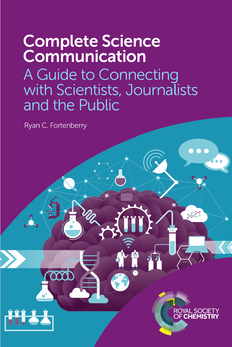Complete Science Communication
Complete Science Communication (1), by Ryan C Fortenberry provides a structured and well-written guide for university science communication courses, and includes a collection of high quality model assignments. The scope covers writing (both technical and non-technical), presentations (talks and posters), and public relations.
|
The text includes nuggets of science communication wisdom that invite the reader to reflect upon the field. The author focuses on the importance of thorough audience foreknowledge and expectations. Ask yourself, he says, “What does my audience already know? What would I like for them to find out?” He expands his analysis to examine our ability to “code switch” – to communicate with different audiences and using different media, and points out potential pitfalls. For example, questions are often used for titles or openings, but these can be counter-effective if the audience’s answer is “No”. Examples specific to chemistry include the challenge of linguistic barriers and how geochemists and biochemists relate to each other.
|
Whilst Fortenberry clearly outlines his audience, he does not outline his scope so clearly. Fortenberry interprets “science communication” only as it pertains to universities, and science communication outside academia is never mentioned. As such, the title and even the introduction are misleading – the book is not a complete view of science communication, but a limited and skewed one. A significant proportion of the book consists of information such as the research paper review process, public relations, and the challenge of reproducibility of scientific results. These explanations provide a concise and useful guide to university dissemination processes, but are not always science communication, nor science.
The text also lacks some critical balance: Fortenberry advises scientists to write like journalists, alluding not to the typical but the model journalist and never critiques any part of their role in information dissemination. He defends blunders like weekly “cure for cancer” stories as a natural misinterpretation of the incremental nature of breakthroughs in research.
Fortenberry presents a set of highly specific rules for best practice science communication (poster presenters should have a 30 s, 60 s and 3 min pitches; use a picture for anything that takes more than 10 words to describe), but breaks many himself. Some rules can be extended ad ridiculum – such as “the higher the citation to word ratio, the better”. Elsewhere, he moderates earlier advice such as advocating information density by then providing guidance on cutting content. Furthermore, many of the most important communications challenges are soft skills. There is barely a mention for how to initiate a conversation, stand confidently on stage, weave your lecture into a story or project your voice. More crucial is the absolutely erroneous advice that presentations are optimal with white backgrounds and black text. Research into human visual processing (2) has shown that light grey text on a navy background or the reverse is significantly easier on the eye, especially for those with visual impediments.
Summary
Complete Science Communication is an account of the personal science communication experience of its author. It does not cover a wide scope of science communication and gaps emerge in what it does encompass. However, it does provide a thorough resource of lesson plans and assignments to inspire and support the university-based science communication educator.
References
1. Complete Science Communication, Ryan C Fortenberry
ISBN: 978-1-78801-110-5, Royal Society of Chemistry, www.rsc.org/books
2. World Blind Union PowerPoint Guidelines, World Blind Union Low Vision Working Group (2007)
www.rnib.org.uk/sites/default/files/WBU%20visual%20presentations%20guidelines.pdf
The text also lacks some critical balance: Fortenberry advises scientists to write like journalists, alluding not to the typical but the model journalist and never critiques any part of their role in information dissemination. He defends blunders like weekly “cure for cancer” stories as a natural misinterpretation of the incremental nature of breakthroughs in research.
Fortenberry presents a set of highly specific rules for best practice science communication (poster presenters should have a 30 s, 60 s and 3 min pitches; use a picture for anything that takes more than 10 words to describe), but breaks many himself. Some rules can be extended ad ridiculum – such as “the higher the citation to word ratio, the better”. Elsewhere, he moderates earlier advice such as advocating information density by then providing guidance on cutting content. Furthermore, many of the most important communications challenges are soft skills. There is barely a mention for how to initiate a conversation, stand confidently on stage, weave your lecture into a story or project your voice. More crucial is the absolutely erroneous advice that presentations are optimal with white backgrounds and black text. Research into human visual processing (2) has shown that light grey text on a navy background or the reverse is significantly easier on the eye, especially for those with visual impediments.
Summary
Complete Science Communication is an account of the personal science communication experience of its author. It does not cover a wide scope of science communication and gaps emerge in what it does encompass. However, it does provide a thorough resource of lesson plans and assignments to inspire and support the university-based science communication educator.
References
1. Complete Science Communication, Ryan C Fortenberry
ISBN: 978-1-78801-110-5, Royal Society of Chemistry, www.rsc.org/books
2. World Blind Union PowerPoint Guidelines, World Blind Union Low Vision Working Group (2007)
www.rnib.org.uk/sites/default/files/WBU%20visual%20presentations%20guidelines.pdf


